ACCT20075 - Auditing and Assurance: Janus Henderson Group Analysis
VerifiedAdded on 2023/06/08
|10
|2412
|464
Report
AI Summary
This report provides a detailed analysis of the audit and assurance processes for the Janus Henderson Group, focusing on the financial year 2017. It begins by explaining the concept of materiality and its application in auditing, including the calculation of a materiality level for the Janus Henderson Group based on its net income. The report then examines the use of preliminary analytical reviews, key ratios, and risk assessment procedures to identify potential areas of concern in the company's financial statements. Specific audit procedures are recommended to address these risks, focusing on areas like fixed assets, trade receivables, sales turnover, and current liabilities. Furthermore, the cash flow statement is reviewed to assess the company's investing and financing activities, and the audit report is analyzed to confirm the unqualified opinion. The report concludes that the audit provides a fair presentation of the company's financial information, highlighting the importance of adhering to applicable laws and regulations to ensure transparency and maintain stakeholder trust. Desklib offers a range of solved assignments and past papers to aid students in their studies.

Janus Henderson Group
Auditing reporting and assurance
Auditing and assurance
Name of the Author
University Name-
Auditing reporting and assurance
Auditing and assurance
Name of the Author
University Name-
Paraphrase This Document
Need a fresh take? Get an instant paraphrase of this document with our AI Paraphraser

Table of Contents
INTRODUCTION.................................................................................................................................2
Answer to section-1...............................................................................................................................2
Answer to section- 2..............................................................................................................................3
Answer to section- 3..............................................................................................................................7
REVIEW OF STATEMENT OF CASH FLOW...............................................................................7
REVIEW OF AUDIT REPORT........................................................................................................8
Conclusion.............................................................................................................................................8
REFERENCES......................................................................................................................................9
1
INTRODUCTION.................................................................................................................................2
Answer to section-1...............................................................................................................................2
Answer to section- 2..............................................................................................................................3
Answer to section- 3..............................................................................................................................7
REVIEW OF STATEMENT OF CASH FLOW...............................................................................7
REVIEW OF AUDIT REPORT........................................................................................................8
Conclusion.............................................................................................................................................8
REFERENCES......................................................................................................................................9
1
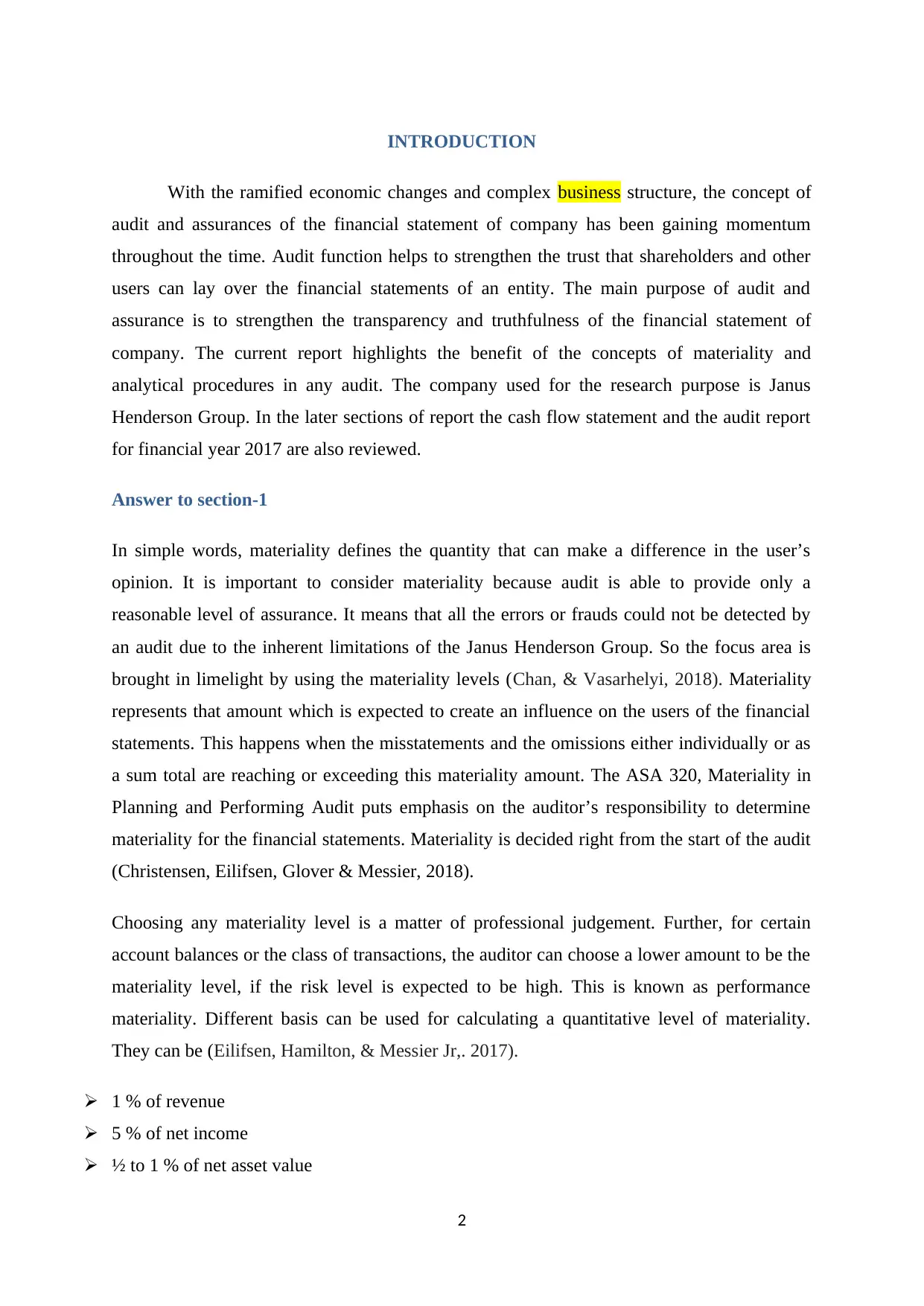
INTRODUCTION
With the ramified economic changes and complex business structure, the concept of
audit and assurances of the financial statement of company has been gaining momentum
throughout the time. Audit function helps to strengthen the trust that shareholders and other
users can lay over the financial statements of an entity. The main purpose of audit and
assurance is to strengthen the transparency and truthfulness of the financial statement of
company. The current report highlights the benefit of the concepts of materiality and
analytical procedures in any audit. The company used for the research purpose is Janus
Henderson Group. In the later sections of report the cash flow statement and the audit report
for financial year 2017 are also reviewed.
Answer to section-1
In simple words, materiality defines the quantity that can make a difference in the user’s
opinion. It is important to consider materiality because audit is able to provide only a
reasonable level of assurance. It means that all the errors or frauds could not be detected by
an audit due to the inherent limitations of the Janus Henderson Group. So the focus area is
brought in limelight by using the materiality levels (Chan, & Vasarhelyi, 2018). Materiality
represents that amount which is expected to create an influence on the users of the financial
statements. This happens when the misstatements and the omissions either individually or as
a sum total are reaching or exceeding this materiality amount. The ASA 320, Materiality in
Planning and Performing Audit puts emphasis on the auditor’s responsibility to determine
materiality for the financial statements. Materiality is decided right from the start of the audit
(Christensen, Eilifsen, Glover & Messier, 2018).
Choosing any materiality level is a matter of professional judgement. Further, for certain
account balances or the class of transactions, the auditor can choose a lower amount to be the
materiality level, if the risk level is expected to be high. This is known as performance
materiality. Different basis can be used for calculating a quantitative level of materiality.
They can be (Eilifsen, Hamilton, & Messier Jr,. 2017).
1 % of revenue
5 % of net income
½ to 1 % of net asset value
2
With the ramified economic changes and complex business structure, the concept of
audit and assurances of the financial statement of company has been gaining momentum
throughout the time. Audit function helps to strengthen the trust that shareholders and other
users can lay over the financial statements of an entity. The main purpose of audit and
assurance is to strengthen the transparency and truthfulness of the financial statement of
company. The current report highlights the benefit of the concepts of materiality and
analytical procedures in any audit. The company used for the research purpose is Janus
Henderson Group. In the later sections of report the cash flow statement and the audit report
for financial year 2017 are also reviewed.
Answer to section-1
In simple words, materiality defines the quantity that can make a difference in the user’s
opinion. It is important to consider materiality because audit is able to provide only a
reasonable level of assurance. It means that all the errors or frauds could not be detected by
an audit due to the inherent limitations of the Janus Henderson Group. So the focus area is
brought in limelight by using the materiality levels (Chan, & Vasarhelyi, 2018). Materiality
represents that amount which is expected to create an influence on the users of the financial
statements. This happens when the misstatements and the omissions either individually or as
a sum total are reaching or exceeding this materiality amount. The ASA 320, Materiality in
Planning and Performing Audit puts emphasis on the auditor’s responsibility to determine
materiality for the financial statements. Materiality is decided right from the start of the audit
(Christensen, Eilifsen, Glover & Messier, 2018).
Choosing any materiality level is a matter of professional judgement. Further, for certain
account balances or the class of transactions, the auditor can choose a lower amount to be the
materiality level, if the risk level is expected to be high. This is known as performance
materiality. Different basis can be used for calculating a quantitative level of materiality.
They can be (Eilifsen, Hamilton, & Messier Jr,. 2017).
1 % of revenue
5 % of net income
½ to 1 % of net asset value
2
⊘ This is a preview!⊘
Do you want full access?
Subscribe today to unlock all pages.

Trusted by 1+ million students worldwide
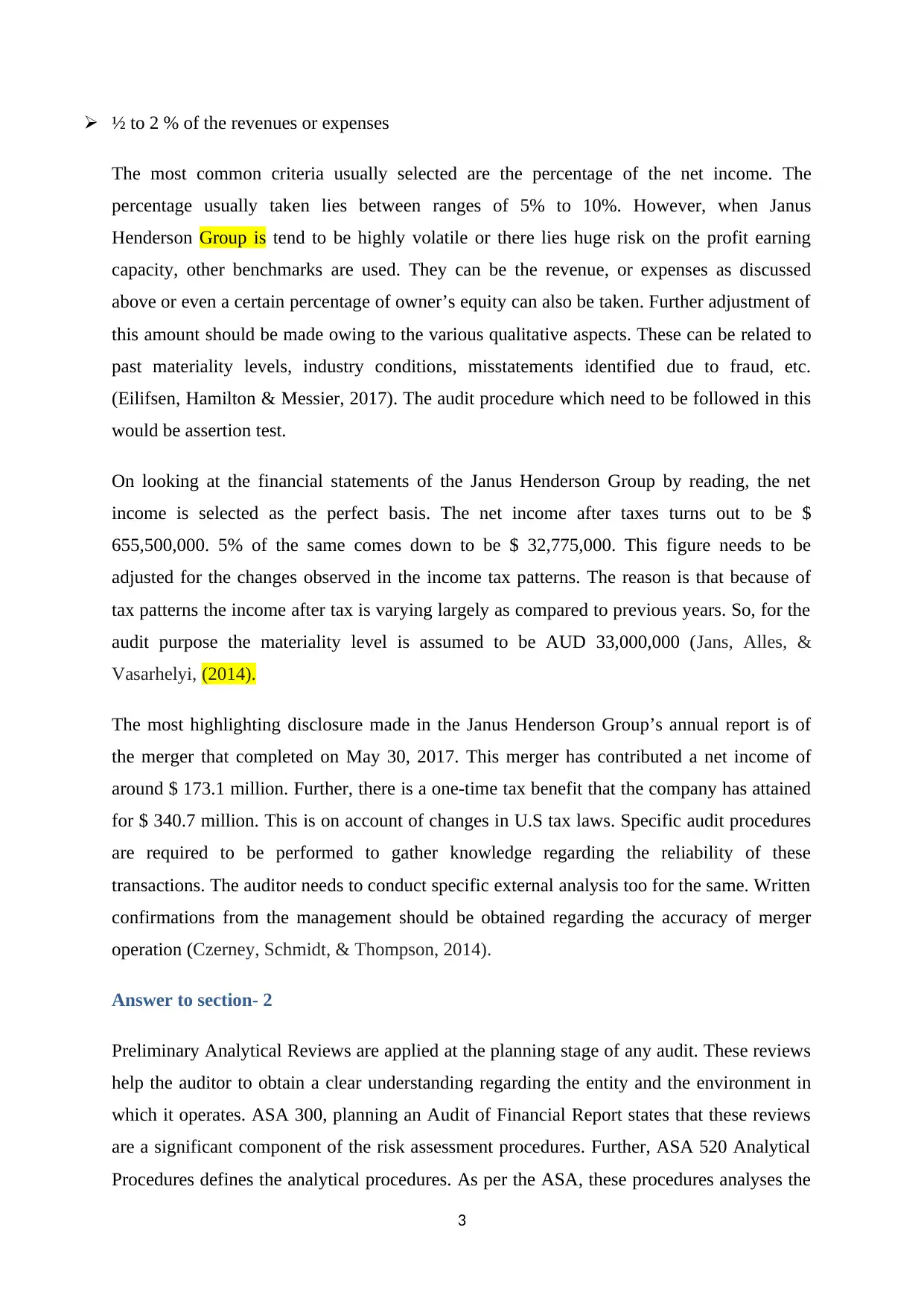
½ to 2 % of the revenues or expenses
The most common criteria usually selected are the percentage of the net income. The
percentage usually taken lies between ranges of 5% to 10%. However, when Janus
Henderson Group is tend to be highly volatile or there lies huge risk on the profit earning
capacity, other benchmarks are used. They can be the revenue, or expenses as discussed
above or even a certain percentage of owner’s equity can also be taken. Further adjustment of
this amount should be made owing to the various qualitative aspects. These can be related to
past materiality levels, industry conditions, misstatements identified due to fraud, etc.
(Eilifsen, Hamilton & Messier, 2017). The audit procedure which need to be followed in this
would be assertion test.
On looking at the financial statements of the Janus Henderson Group by reading, the net
income is selected as the perfect basis. The net income after taxes turns out to be $
655,500,000. 5% of the same comes down to be $ 32,775,000. This figure needs to be
adjusted for the changes observed in the income tax patterns. The reason is that because of
tax patterns the income after tax is varying largely as compared to previous years. So, for the
audit purpose the materiality level is assumed to be AUD 33,000,000 (Jans, Alles, &
Vasarhelyi, (2014).
The most highlighting disclosure made in the Janus Henderson Group’s annual report is of
the merger that completed on May 30, 2017. This merger has contributed a net income of
around $ 173.1 million. Further, there is a one-time tax benefit that the company has attained
for $ 340.7 million. This is on account of changes in U.S tax laws. Specific audit procedures
are required to be performed to gather knowledge regarding the reliability of these
transactions. The auditor needs to conduct specific external analysis too for the same. Written
confirmations from the management should be obtained regarding the accuracy of merger
operation (Czerney, Schmidt, & Thompson, 2014).
Answer to section- 2
Preliminary Analytical Reviews are applied at the planning stage of any audit. These reviews
help the auditor to obtain a clear understanding regarding the entity and the environment in
which it operates. ASA 300, planning an Audit of Financial Report states that these reviews
are a significant component of the risk assessment procedures. Further, ASA 520 Analytical
Procedures defines the analytical procedures. As per the ASA, these procedures analyses the
3
The most common criteria usually selected are the percentage of the net income. The
percentage usually taken lies between ranges of 5% to 10%. However, when Janus
Henderson Group is tend to be highly volatile or there lies huge risk on the profit earning
capacity, other benchmarks are used. They can be the revenue, or expenses as discussed
above or even a certain percentage of owner’s equity can also be taken. Further adjustment of
this amount should be made owing to the various qualitative aspects. These can be related to
past materiality levels, industry conditions, misstatements identified due to fraud, etc.
(Eilifsen, Hamilton & Messier, 2017). The audit procedure which need to be followed in this
would be assertion test.
On looking at the financial statements of the Janus Henderson Group by reading, the net
income is selected as the perfect basis. The net income after taxes turns out to be $
655,500,000. 5% of the same comes down to be $ 32,775,000. This figure needs to be
adjusted for the changes observed in the income tax patterns. The reason is that because of
tax patterns the income after tax is varying largely as compared to previous years. So, for the
audit purpose the materiality level is assumed to be AUD 33,000,000 (Jans, Alles, &
Vasarhelyi, (2014).
The most highlighting disclosure made in the Janus Henderson Group’s annual report is of
the merger that completed on May 30, 2017. This merger has contributed a net income of
around $ 173.1 million. Further, there is a one-time tax benefit that the company has attained
for $ 340.7 million. This is on account of changes in U.S tax laws. Specific audit procedures
are required to be performed to gather knowledge regarding the reliability of these
transactions. The auditor needs to conduct specific external analysis too for the same. Written
confirmations from the management should be obtained regarding the accuracy of merger
operation (Czerney, Schmidt, & Thompson, 2014).
Answer to section- 2
Preliminary Analytical Reviews are applied at the planning stage of any audit. These reviews
help the auditor to obtain a clear understanding regarding the entity and the environment in
which it operates. ASA 300, planning an Audit of Financial Report states that these reviews
are a significant component of the risk assessment procedures. Further, ASA 520 Analytical
Procedures defines the analytical procedures. As per the ASA, these procedures analyses the
3
Paraphrase This Document
Need a fresh take? Get an instant paraphrase of this document with our AI Paraphraser

relationship that lies between the financial and non-financial information. This analysis helps
to evaluate the financial information (Jans, Alles & Vasarhelyi, 2014).
KEY RATIOS 2014 2015 2016 2017
CURRENT
RATIO
1.91 1.47 1.73 2.23
FINANCIAL
LEVERAGE
1.61 1.63 1.52 1.50
NET MARGIN
(%)
39.70 21.32 14.85 37.59
RETURN ON
ASSETS (%)
16.34 9.45 6.01 14.15
RETURN ON
EQUITY (%)
27.20 15.32 9.49 21.31
RETURN ON
INVESTED
CAPITAL (%)
23.86 13.80 9.25 17.17
RECEIVABLES
TURNOVER
2.57 2.89 2.66 4.60
FIXED ASSETS
TURNOVER
39.33 49.96 47.32 39.74
4
to evaluate the financial information (Jans, Alles & Vasarhelyi, 2014).
KEY RATIOS 2014 2015 2016 2017
CURRENT
RATIO
1.91 1.47 1.73 2.23
FINANCIAL
LEVERAGE
1.61 1.63 1.52 1.50
NET MARGIN
(%)
39.70 21.32 14.85 37.59
RETURN ON
ASSETS (%)
16.34 9.45 6.01 14.15
RETURN ON
EQUITY (%)
27.20 15.32 9.49 21.31
RETURN ON
INVESTED
CAPITAL (%)
23.86 13.80 9.25 17.17
RECEIVABLES
TURNOVER
2.57 2.89 2.66 4.60
FIXED ASSETS
TURNOVER
39.33 49.96 47.32 39.74
4
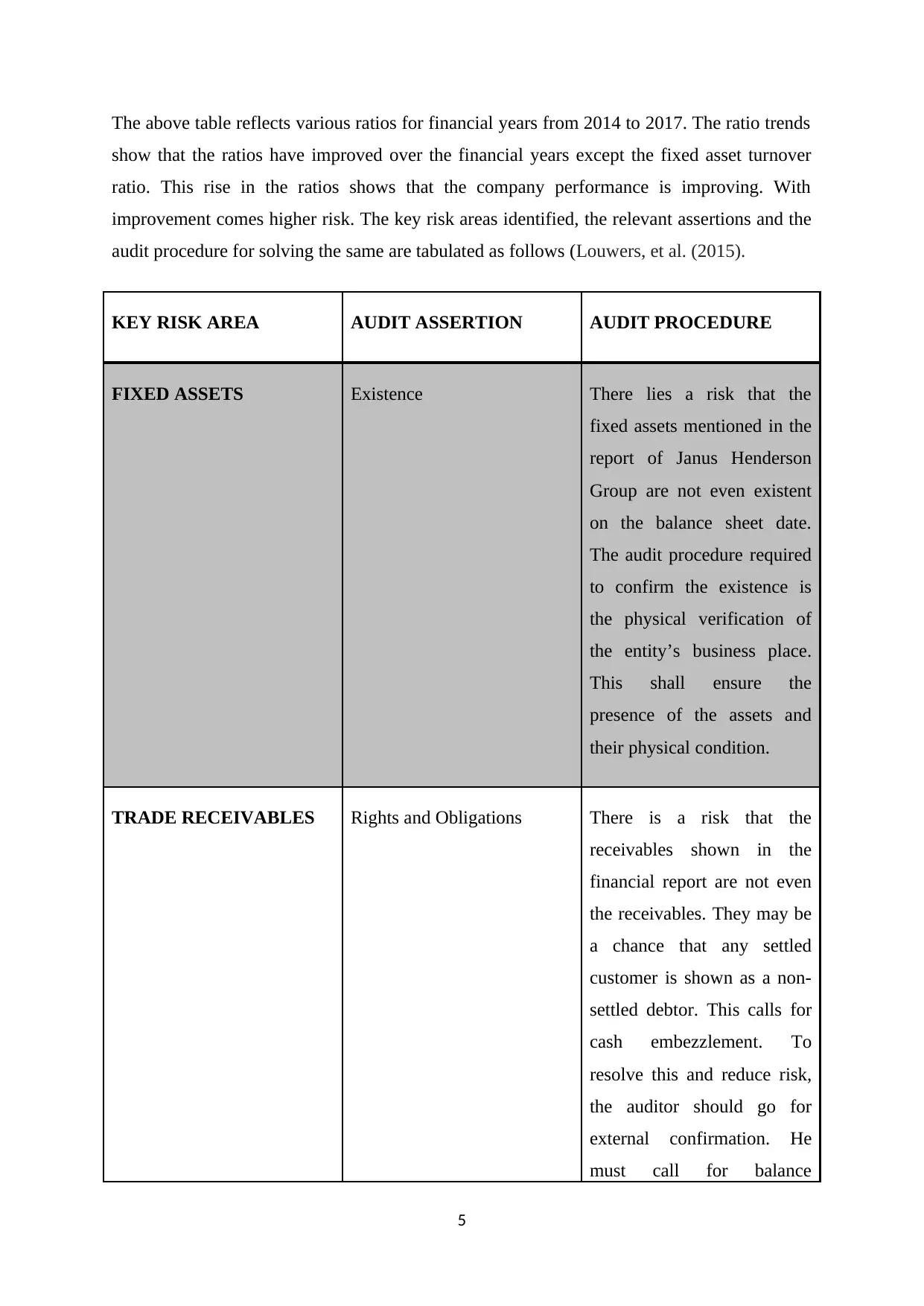
The above table reflects various ratios for financial years from 2014 to 2017. The ratio trends
show that the ratios have improved over the financial years except the fixed asset turnover
ratio. This rise in the ratios shows that the company performance is improving. With
improvement comes higher risk. The key risk areas identified, the relevant assertions and the
audit procedure for solving the same are tabulated as follows (Louwers, et al. (2015).
KEY RISK AREA AUDIT ASSERTION AUDIT PROCEDURE
FIXED ASSETS Existence There lies a risk that the
fixed assets mentioned in the
report of Janus Henderson
Group are not even existent
on the balance sheet date.
The audit procedure required
to confirm the existence is
the physical verification of
the entity’s business place.
This shall ensure the
presence of the assets and
their physical condition.
TRADE RECEIVABLES Rights and Obligations There is a risk that the
receivables shown in the
financial report are not even
the receivables. They may be
a chance that any settled
customer is shown as a non-
settled debtor. This calls for
cash embezzlement. To
resolve this and reduce risk,
the auditor should go for
external confirmation. He
must call for balance
5
show that the ratios have improved over the financial years except the fixed asset turnover
ratio. This rise in the ratios shows that the company performance is improving. With
improvement comes higher risk. The key risk areas identified, the relevant assertions and the
audit procedure for solving the same are tabulated as follows (Louwers, et al. (2015).
KEY RISK AREA AUDIT ASSERTION AUDIT PROCEDURE
FIXED ASSETS Existence There lies a risk that the
fixed assets mentioned in the
report of Janus Henderson
Group are not even existent
on the balance sheet date.
The audit procedure required
to confirm the existence is
the physical verification of
the entity’s business place.
This shall ensure the
presence of the assets and
their physical condition.
TRADE RECEIVABLES Rights and Obligations There is a risk that the
receivables shown in the
financial report are not even
the receivables. They may be
a chance that any settled
customer is shown as a non-
settled debtor. This calls for
cash embezzlement. To
resolve this and reduce risk,
the auditor should go for
external confirmation. He
must call for balance
5
⊘ This is a preview!⊘
Do you want full access?
Subscribe today to unlock all pages.

Trusted by 1+ million students worldwide
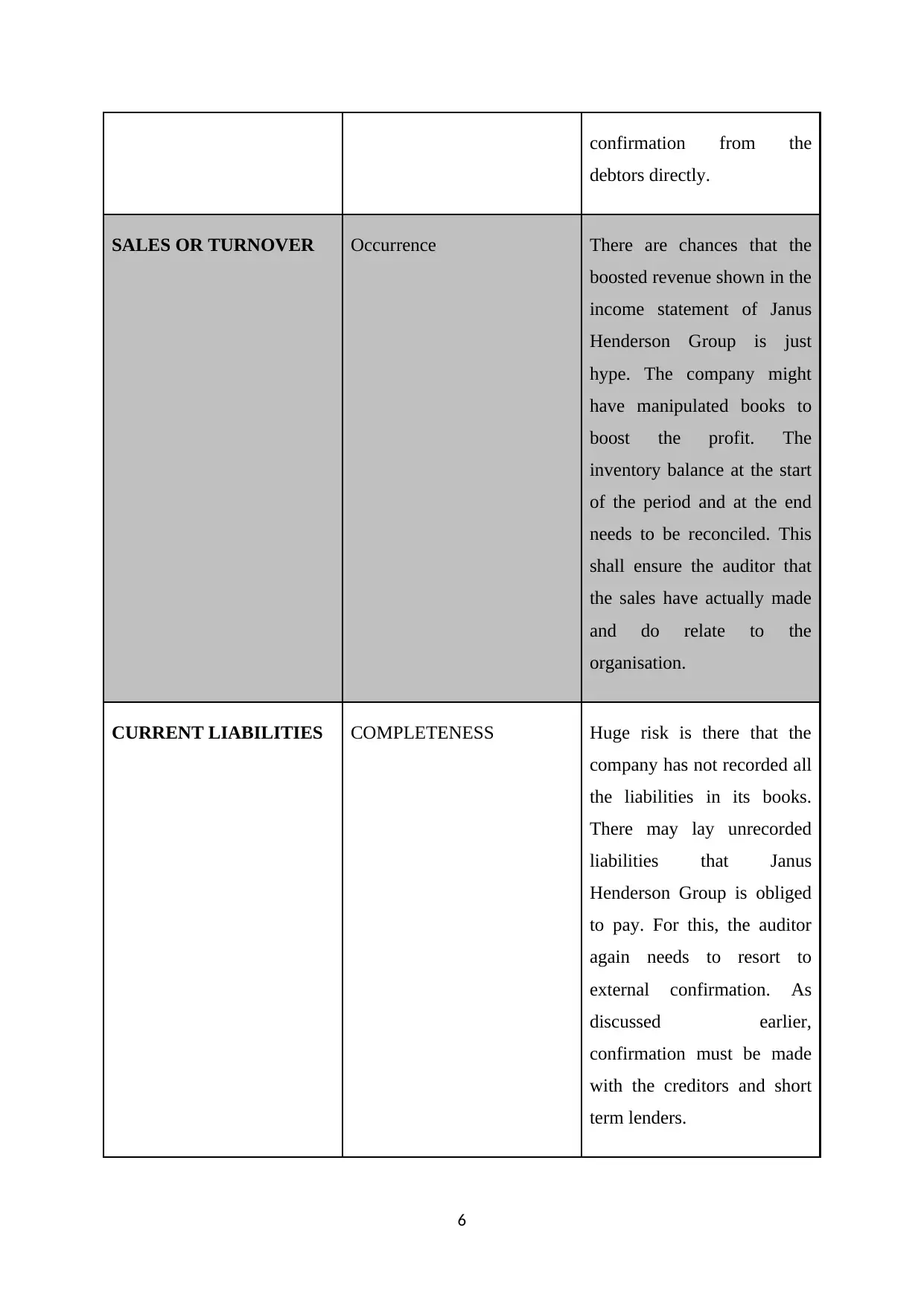
confirmation from the
debtors directly.
SALES OR TURNOVER Occurrence There are chances that the
boosted revenue shown in the
income statement of Janus
Henderson Group is just
hype. The company might
have manipulated books to
boost the profit. The
inventory balance at the start
of the period and at the end
needs to be reconciled. This
shall ensure the auditor that
the sales have actually made
and do relate to the
organisation.
CURRENT LIABILITIES COMPLETENESS Huge risk is there that the
company has not recorded all
the liabilities in its books.
There may lay unrecorded
liabilities that Janus
Henderson Group is obliged
to pay. For this, the auditor
again needs to resort to
external confirmation. As
discussed earlier,
confirmation must be made
with the creditors and short
term lenders.
6
debtors directly.
SALES OR TURNOVER Occurrence There are chances that the
boosted revenue shown in the
income statement of Janus
Henderson Group is just
hype. The company might
have manipulated books to
boost the profit. The
inventory balance at the start
of the period and at the end
needs to be reconciled. This
shall ensure the auditor that
the sales have actually made
and do relate to the
organisation.
CURRENT LIABILITIES COMPLETENESS Huge risk is there that the
company has not recorded all
the liabilities in its books.
There may lay unrecorded
liabilities that Janus
Henderson Group is obliged
to pay. For this, the auditor
again needs to resort to
external confirmation. As
discussed earlier,
confirmation must be made
with the creditors and short
term lenders.
6
Paraphrase This Document
Need a fresh take? Get an instant paraphrase of this document with our AI Paraphraser
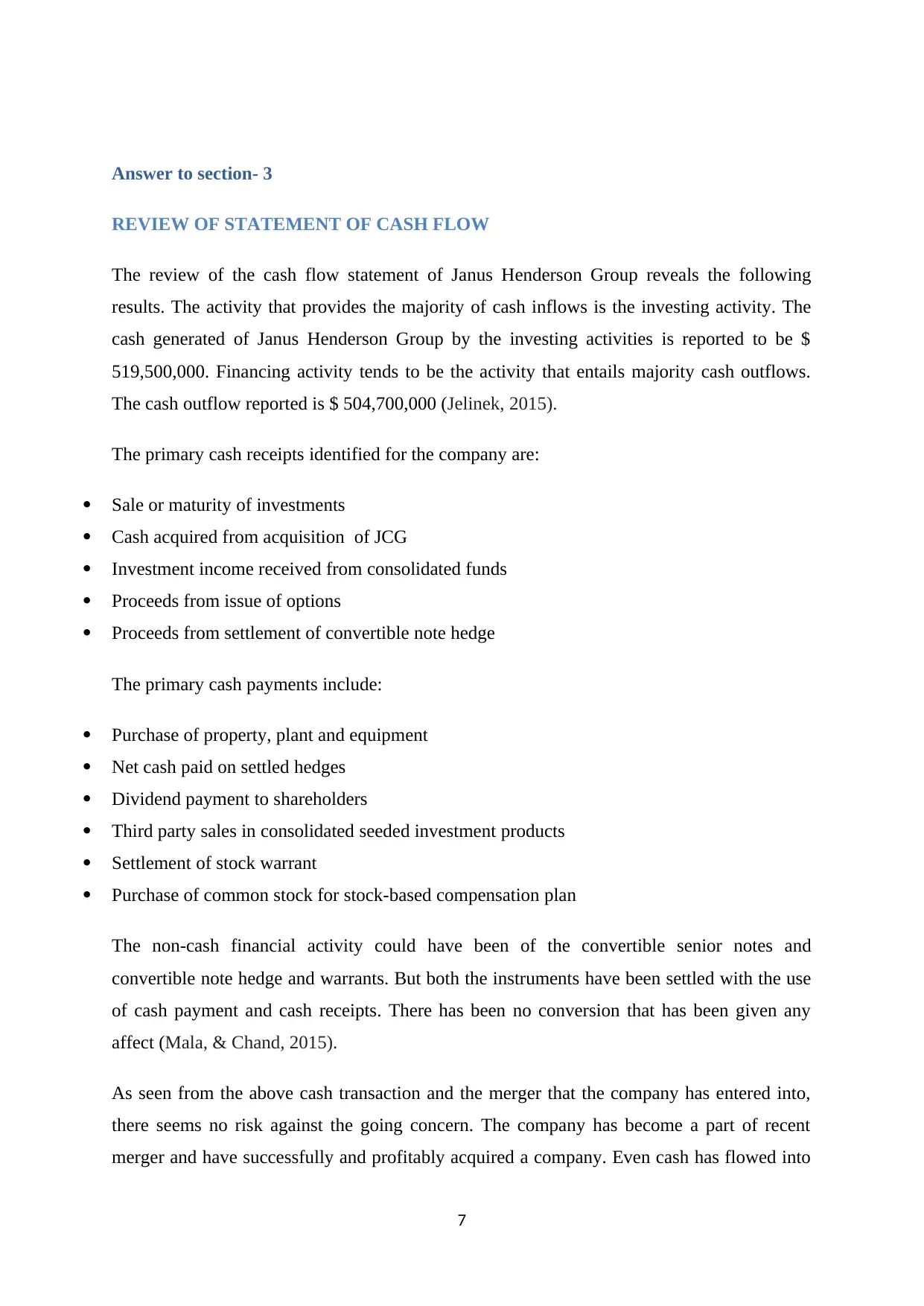
Answer to section- 3
REVIEW OF STATEMENT OF CASH FLOW
The review of the cash flow statement of Janus Henderson Group reveals the following
results. The activity that provides the majority of cash inflows is the investing activity. The
cash generated of Janus Henderson Group by the investing activities is reported to be $
519,500,000. Financing activity tends to be the activity that entails majority cash outflows.
The cash outflow reported is $ 504,700,000 (Jelinek, 2015).
The primary cash receipts identified for the company are:
Sale or maturity of investments
Cash acquired from acquisition of JCG
Investment income received from consolidated funds
Proceeds from issue of options
Proceeds from settlement of convertible note hedge
The primary cash payments include:
Purchase of property, plant and equipment
Net cash paid on settled hedges
Dividend payment to shareholders
Third party sales in consolidated seeded investment products
Settlement of stock warrant
Purchase of common stock for stock-based compensation plan
The non-cash financial activity could have been of the convertible senior notes and
convertible note hedge and warrants. But both the instruments have been settled with the use
of cash payment and cash receipts. There has been no conversion that has been given any
affect (Mala, & Chand, 2015).
As seen from the above cash transaction and the merger that the company has entered into,
there seems no risk against the going concern. The company has become a part of recent
merger and have successfully and profitably acquired a company. Even cash has flowed into
7
REVIEW OF STATEMENT OF CASH FLOW
The review of the cash flow statement of Janus Henderson Group reveals the following
results. The activity that provides the majority of cash inflows is the investing activity. The
cash generated of Janus Henderson Group by the investing activities is reported to be $
519,500,000. Financing activity tends to be the activity that entails majority cash outflows.
The cash outflow reported is $ 504,700,000 (Jelinek, 2015).
The primary cash receipts identified for the company are:
Sale or maturity of investments
Cash acquired from acquisition of JCG
Investment income received from consolidated funds
Proceeds from issue of options
Proceeds from settlement of convertible note hedge
The primary cash payments include:
Purchase of property, plant and equipment
Net cash paid on settled hedges
Dividend payment to shareholders
Third party sales in consolidated seeded investment products
Settlement of stock warrant
Purchase of common stock for stock-based compensation plan
The non-cash financial activity could have been of the convertible senior notes and
convertible note hedge and warrants. But both the instruments have been settled with the use
of cash payment and cash receipts. There has been no conversion that has been given any
affect (Mala, & Chand, 2015).
As seen from the above cash transaction and the merger that the company has entered into,
there seems no risk against the going concern. The company has become a part of recent
merger and have successfully and profitably acquired a company. Even cash has flowed into
7

the newly merged company out of the acquisition. There is cash inflow even on account of
changed taxation policies of U.S. This makes it sure that there is no visible risk on the going
concern of the company. However, there can be a fraud that is hidden and that can harm the
going concern capacity. To reduce the risk of the same, the auditor should try to gather
sufficient and appropriate audit evidence. The control environment should be analysed. Risk
level should be ascertained to identify the level of trust that could be done on entity’s internal
control. Analytical procedures should be performed near the end of audit too to identify any
significant changes (Czerney, Schmidt & Thompson, 2014).
REVIEW OF AUDIT REPORT
The opinion presented in the audit report for financial year of Janus Henderson Group 2017 is
unqualified opinion. The auditor has clearly stated that the presentation of the financial
information is fair in terms with the requirements. There is no qualification or modification or
adversity represented in the audit report by the auditor. The report is issued all clean. The
same is observed from the analysis made in the report. No discrepancies have been observed
in the financial information (Brown-Liburd, Issa, & Lombardi, 2015).
Conclusion
After evaluating all the details and facts about the audit and assurance of the financial
statement of Janus Henderson Group, it could be inferred that auditors needs to comply with
the all the applicable laws and regulations which could be used to strengthen the true and fair
view of the financial statements of company. It has been observed that auditors evaluate
whether company has complied with the accounting standards and applicable laws while
formulating the financial statements. In this assignment, is Janus Henderson Group was
assessed and it was found that auditors gave the non-qualified audit report which reflects that
company has complied with the all the applicable laws and regulations and kept its business
more transparent to its stakeholders.
8
changed taxation policies of U.S. This makes it sure that there is no visible risk on the going
concern of the company. However, there can be a fraud that is hidden and that can harm the
going concern capacity. To reduce the risk of the same, the auditor should try to gather
sufficient and appropriate audit evidence. The control environment should be analysed. Risk
level should be ascertained to identify the level of trust that could be done on entity’s internal
control. Analytical procedures should be performed near the end of audit too to identify any
significant changes (Czerney, Schmidt & Thompson, 2014).
REVIEW OF AUDIT REPORT
The opinion presented in the audit report for financial year of Janus Henderson Group 2017 is
unqualified opinion. The auditor has clearly stated that the presentation of the financial
information is fair in terms with the requirements. There is no qualification or modification or
adversity represented in the audit report by the auditor. The report is issued all clean. The
same is observed from the analysis made in the report. No discrepancies have been observed
in the financial information (Brown-Liburd, Issa, & Lombardi, 2015).
Conclusion
After evaluating all the details and facts about the audit and assurance of the financial
statement of Janus Henderson Group, it could be inferred that auditors needs to comply with
the all the applicable laws and regulations which could be used to strengthen the true and fair
view of the financial statements of company. It has been observed that auditors evaluate
whether company has complied with the accounting standards and applicable laws while
formulating the financial statements. In this assignment, is Janus Henderson Group was
assessed and it was found that auditors gave the non-qualified audit report which reflects that
company has complied with the all the applicable laws and regulations and kept its business
more transparent to its stakeholders.
8
⊘ This is a preview!⊘
Do you want full access?
Subscribe today to unlock all pages.

Trusted by 1+ million students worldwide
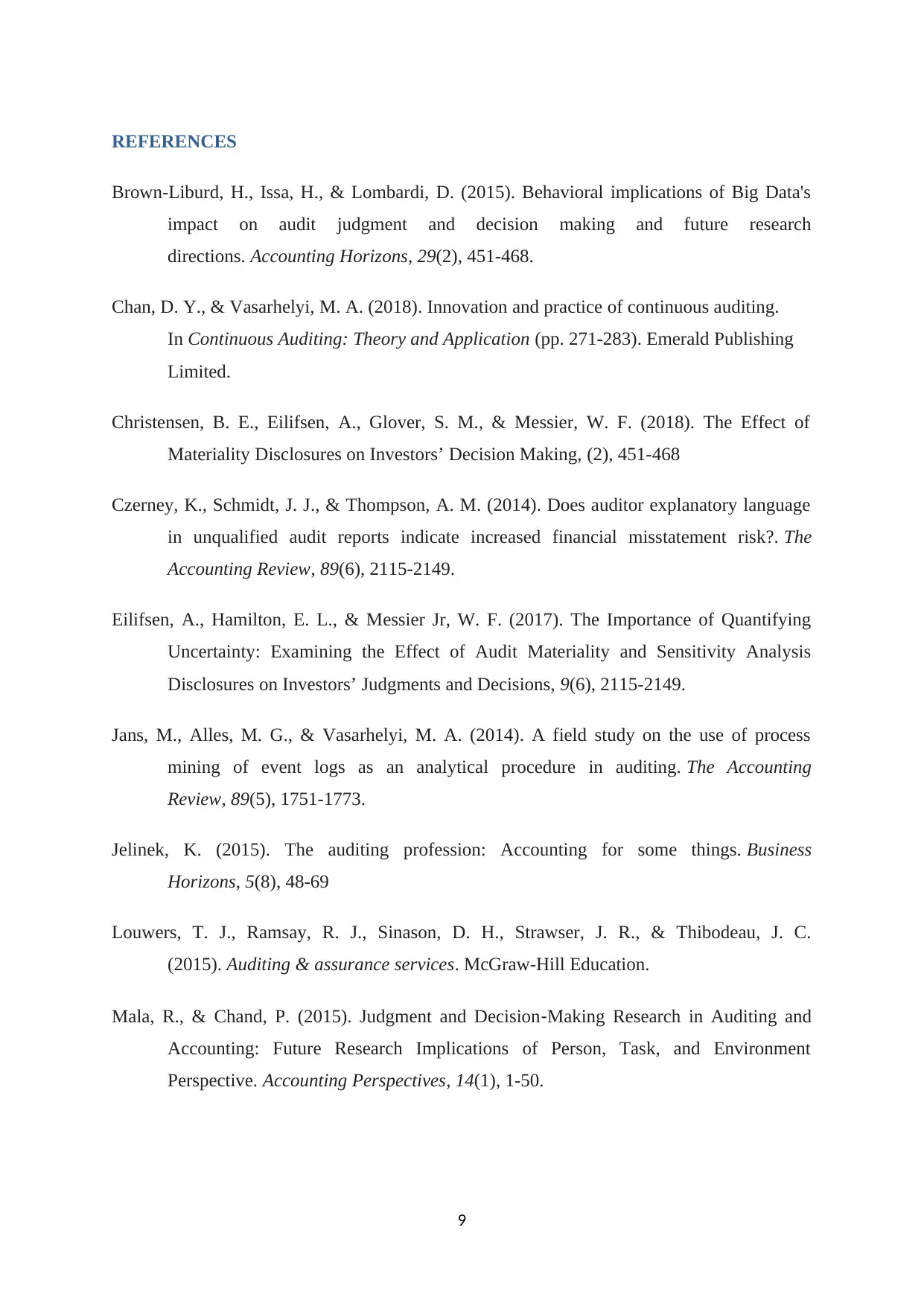
REFERENCES
Brown-Liburd, H., Issa, H., & Lombardi, D. (2015). Behavioral implications of Big Data's
impact on audit judgment and decision making and future research
directions. Accounting Horizons, 29(2), 451-468.
Chan, D. Y., & Vasarhelyi, M. A. (2018). Innovation and practice of continuous auditing.
In Continuous Auditing: Theory and Application (pp. 271-283). Emerald Publishing
Limited.
Christensen, B. E., Eilifsen, A., Glover, S. M., & Messier, W. F. (2018). The Effect of
Materiality Disclosures on Investors’ Decision Making, (2), 451-468
Czerney, K., Schmidt, J. J., & Thompson, A. M. (2014). Does auditor explanatory language
in unqualified audit reports indicate increased financial misstatement risk?. The
Accounting Review, 89(6), 2115-2149.
Eilifsen, A., Hamilton, E. L., & Messier Jr, W. F. (2017). The Importance of Quantifying
Uncertainty: Examining the Effect of Audit Materiality and Sensitivity Analysis
Disclosures on Investors’ Judgments and Decisions, 9(6), 2115-2149.
Jans, M., Alles, M. G., & Vasarhelyi, M. A. (2014). A field study on the use of process
mining of event logs as an analytical procedure in auditing. The Accounting
Review, 89(5), 1751-1773.
Jelinek, K. (2015). The auditing profession: Accounting for some things. Business
Horizons, 5(8), 48-69
Louwers, T. J., Ramsay, R. J., Sinason, D. H., Strawser, J. R., & Thibodeau, J. C.
(2015). Auditing & assurance services. McGraw-Hill Education.
Mala, R., & Chand, P. (2015). Judgment and Decision‐Making Research in Auditing and
Accounting: Future Research Implications of Person, Task, and Environment
Perspective. Accounting Perspectives, 14(1), 1-50.
9
Brown-Liburd, H., Issa, H., & Lombardi, D. (2015). Behavioral implications of Big Data's
impact on audit judgment and decision making and future research
directions. Accounting Horizons, 29(2), 451-468.
Chan, D. Y., & Vasarhelyi, M. A. (2018). Innovation and practice of continuous auditing.
In Continuous Auditing: Theory and Application (pp. 271-283). Emerald Publishing
Limited.
Christensen, B. E., Eilifsen, A., Glover, S. M., & Messier, W. F. (2018). The Effect of
Materiality Disclosures on Investors’ Decision Making, (2), 451-468
Czerney, K., Schmidt, J. J., & Thompson, A. M. (2014). Does auditor explanatory language
in unqualified audit reports indicate increased financial misstatement risk?. The
Accounting Review, 89(6), 2115-2149.
Eilifsen, A., Hamilton, E. L., & Messier Jr, W. F. (2017). The Importance of Quantifying
Uncertainty: Examining the Effect of Audit Materiality and Sensitivity Analysis
Disclosures on Investors’ Judgments and Decisions, 9(6), 2115-2149.
Jans, M., Alles, M. G., & Vasarhelyi, M. A. (2014). A field study on the use of process
mining of event logs as an analytical procedure in auditing. The Accounting
Review, 89(5), 1751-1773.
Jelinek, K. (2015). The auditing profession: Accounting for some things. Business
Horizons, 5(8), 48-69
Louwers, T. J., Ramsay, R. J., Sinason, D. H., Strawser, J. R., & Thibodeau, J. C.
(2015). Auditing & assurance services. McGraw-Hill Education.
Mala, R., & Chand, P. (2015). Judgment and Decision‐Making Research in Auditing and
Accounting: Future Research Implications of Person, Task, and Environment
Perspective. Accounting Perspectives, 14(1), 1-50.
9
1 out of 10
Related Documents
Your All-in-One AI-Powered Toolkit for Academic Success.
+13062052269
info@desklib.com
Available 24*7 on WhatsApp / Email
![[object Object]](/_next/static/media/star-bottom.7253800d.svg)
Unlock your academic potential
Copyright © 2020–2025 A2Z Services. All Rights Reserved. Developed and managed by ZUCOL.





